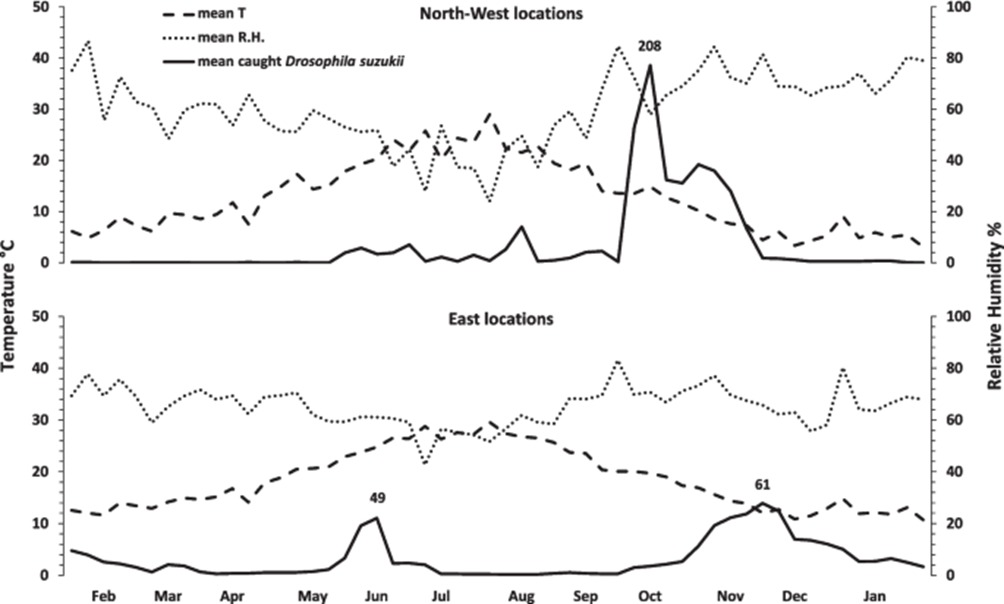Portrait of a sweet cherry breeder: Gregorio Lopez-Ortega
18 Jan 2024
n this article, José Quero García, member of the technical-scientific committee of Cherry Times, interviewed Gregorio Lopez-Ortega, breeder at the Chilean company Hortifrut.
Drosophila suzukii is an invasive insect, originally from Asia, known for its ability to lay eggs in ripe fruits, causing significant economic damage to farmers. This fly poses a threat to fruit crops in many regions worldwide, including Italy.
A recent study conducted on the slopes of Mount Etna (Italy) analyzed the seasonal activity, population genetics, and presence of parasitoids potentially useful for the biological control of this insect in the area.
The study was carried out in five locations distributed between the eastern and northwestern slopes of Etna, with a year-long monitoring period. The captures of Drosophila suzukii showed a clear influence of local climatic conditions: in the warmer areas of the eastern slope, the insect was present year-round, with two peaks in late spring and autumn.
Conversely, in the colder locations of the northwestern slope, the Drosophila suzukii population was significantly reduced during winter months, with a notable resurgence in summer and autumn. Humidity and temperature influenced population dynamics: high temperatures reduced captures, while increases in humidity favored the fly’s presence.
 Image 1. Catches of Drosophila suzukii showed a clear influence of local climatic conditions:
Image 1. Catches of Drosophila suzukii showed a clear influence of local climatic conditions:
The genetic analysis of the Drosophila suzukii population revealed that individuals collected on Mount Etna share a single genetic origin, suggesting a single introduction of the species into the region. Genetic data show similarities with populations present in Europe, North America, and South Korea, confirming a high genetic homogeneity among European populations of this invasive insect. This common genetic origin may be useful, facilitating the testing of new pest management approaches based on genetic control.
One of the most interesting aspects of the study concerns the search for native parasitoids that could contribute to the biological control of Drosophila suzukii. Three parasitoid species were identified: the larval parasitoid Leptopilina boulardi and the pupal parasitoids Pachycrepoideus vindemiae and Trichopria drosophilae. However, only the pupal parasitoids successfully completed their development cycle on Drosophila suzukii in laboratory tests, while Leptopilina boulardi showed high mortality of host larvae without successfully emerging.
These results are encouraging, as the biological control of Drosophila suzukii using native parasitoids could be feasible, albeit with some limitations. The presence of pupal parasitoids indicates potential for biocontrol, but their actual impact on field populations of Drosophila suzukii remains uncertain and requires further study. The study provides an important foundation for the development of sustainable management programs for Drosophila suzukii in Sicily and other regions with similar climatic conditions. However, it is only a starting point, as the real effectiveness of these native parasitoids under field conditions remains to be evaluated.
 Image 2. Genetic analysis of the Drosophila suzukii population revealed that individuals collected on Etna share a single genetic origin.
Image 2. Genetic analysis of the Drosophila suzukii population revealed that individuals collected on Etna share a single genetic origin.
In general, integrated pest management must consider targeted strategies based on local environmental conditions, combining biological control methods, agronomic practices, and monitoring strategies. Understanding the local seasonal dynamics of Drosophila suzukii and the role of its parasitoids can help farmers plan targeted interventions, reducing insecticide use and promoting effective biological control strategies.
Image sources: Warren H. L. Wong, WaspWeb; Gugliuzzo et al., 2024.
Source: Gugliuzzo, Antonio, Cavallaro, Carmelo, Strano, Cinzia P., Alinç, Tugcan, Passos, Luis C., Ricupero, Michele, Lisi, Fabrizio, Cocuzza, Giuseppe E. Massimino, Colazza, Stefano, Russo, Agatino, Siscaro, Gaetano, Garzia, Giovanna Tropea, Zappalà, Lucia, Biondi, Antonio. Seasonal flight activity of Drosophila suzukii and first data on its population genetics and parasitoid occurrence on Mount Etna (Italy) https://doi.org/10.1007/s12600-024-01206-x
Andrea Giovannini
Università di Bologna (IT)
18 Jan 2024
n this article, José Quero García, member of the technical-scientific committee of Cherry Times, interviewed Gregorio Lopez-Ortega, breeder at the Chilean company Hortifrut.
04 Aug 2023
The Fragsburg farm is located at 700m a.s.l. in the hills above the city of Merano (Bozen). There, in the experimental cherry orchard (about 1.5 ha), different training systems, rootstocks, varieties, and pruning techniques are tested with the purpose of supporting farmers.
07 Jan 2026
A study from Miguel Hernández University in Alicante investigates the effect of melatonin applied before and after harvest on 'Sunburst' cherries. Results show a 29% rise in anthocyanins and a 5x increase in endogenous melatonin after 21 days at 2 °C in cold storage.
07 Jan 2026
In Quincy, Washington, cherry growers Dale and Brandon Goldy bring orchards into production by the third leaf through precise pruning, scoring and plant growth regulators. Their system turns vigor into fruiting wood, reducing blind wood and improving yield and canopy light.